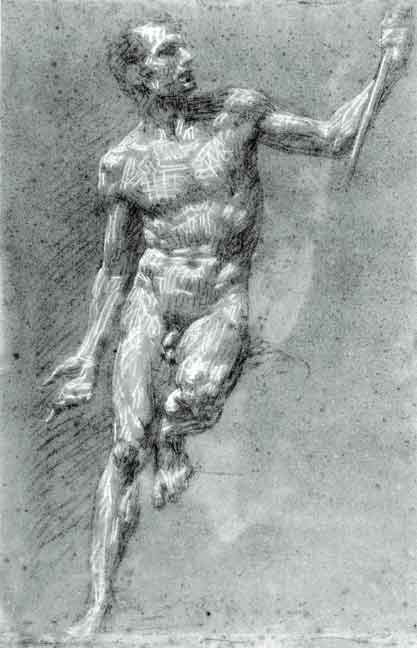
Eyewitness Account

![]() Back
to Method--Step by Step
Back
to Method--Step by Step
![]() Back to Update Page
Back to Update Page
Eyewitness Account
Found in Pierre-Paul Prud'hon
Sylvain Laveissiere
The Metropolitan Museum of Art, New York
Distributed by Harry N. Abrams, Inc., New York
© 1998, ISBN 0-87099-844-7
'Prud'hon's originality, his power, and the hallmark of his genius reside in the fact that he always proceeds from the inside to the outside of the figure. What he looks for on the human body, above all, is light and its traces. The ray of light gives him his line. As soon as he has gently indicated his contours and shadows on the blue paper, placed his reference marks, fixed his proportions, he quickly gives these first notations a wipe of his handkerchief and the black chalk vanishes into a mist of charcoal. He begins to conjure his figure drawing out of the soft ground and clear night of his paper with straight, widely spaced strokes, which he traces along the lines of the muscles and crosses only at the joints. Out of these patterns, under this armature of white, a luminous ecorché seems to arise. Then he thickens the shadows. With bold and broad strokes, the artist envelops--rather than fixes--the contours of his figure, and lets the extremities float, bathed in the ambient light, delineated and caressed by a tentative line. Now he goes back to modeling the light, strengthens the values, kneads and presses the strokes of white chalk that form lozenges on the tendons and muscles, and streaks the pectorals with the luminous relief of the Parthenon horsemen. Then, a piece of Indian muslin used as a stump fuses the whole together. A smooth and muted velvet gray tonality remains in the shadows, which Prud'hon accentuates here and there with strokes of his black chalk. Now comes the last stage of the drawing: the white chalk is pressed into service again, scoring the page; but this time, Prud'hon proceeds with small strokes, lovingly polishing the figure, modulating the slightest fleck of light, rendering the slightest curve in the surfaces, and stops only when the teeming scores of crisscrossed lines have quickened the human form into life.'*
* Goncourt 1861, p. I7; Goncourt 1895, PP. 386-88. In the quoted passage, "mist of charcoal" refers to an effect resembling charcoal drawing. Prud'hon used only chalk, and not charcoal, as has often been assumed. For a good example of the artist's next steps, resulting in "a luminous ecorché," see figure below.

![]()
![]() Next
Page: Demonstration: Step 1 -- Outline
Next
Page: Demonstration: Step 1 -- Outline
What's New? | Shortcut
Entrances: | Studio -|
Alzofon Art Institute
-| Idea Library | Academy | Guest Wing |
Rebecca Alzofon can be e-mailed
at rebecca@art.net
This page updated March 4, 2002
![]() 1999 by Rebecca Alzofon.
All rights reserved.
1999 by Rebecca Alzofon.
All rights reserved.